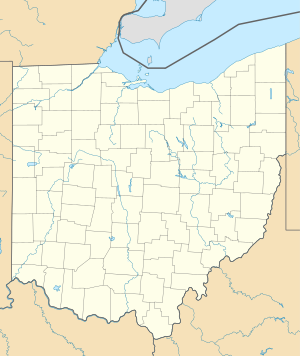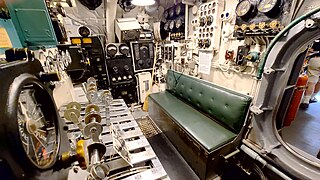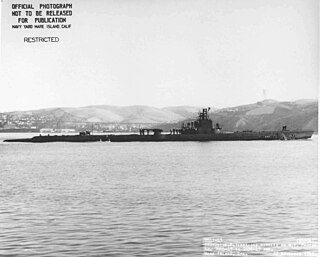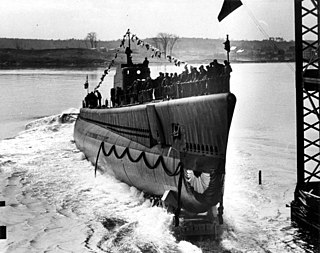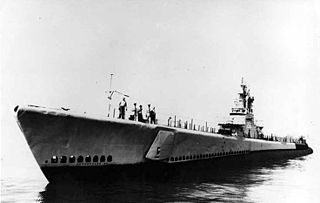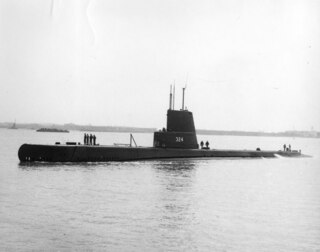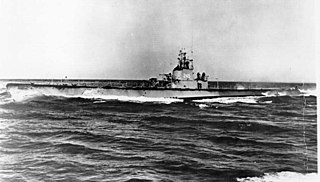 USS Cod (SS-224) underway off Block Island, Rhode Island. 1951 December | |
| History | |
|---|---|
| Name | USS Cod |
| Namesake | Cod |
| Ordered | 9 September 1940 |
| Builder | Electric Boat Company, Groton, Connecticut [1] |
| Laid down | 21 July 1942 [2] [3] |
| Launched | 21 March 1943 [2] |
| Sponsored by | Mrs. G.M. Mahoney |
| Acquired | 21 June 1943 |
| Commissioned | 21 June 1943 [2] |
| Decommissioned | 21 June 1954 |
| In service | 21 March 1943 |
| Out of service | 15 December 1971 |
| Reclassified | AGSS-224, 1 December 1962, IXSS-224, 30 June 1971 |
| Stricken | 15 December 1971 [2] |
| Honors and awards | Seven |
| Status | Museum ship and memorial in Cleveland, Ohio since 1 May 1976 [4] |
| Badge | 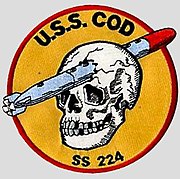 |
| General characteristics | |
| Class and type | Gato-class diesel-electric submarine [4] |
| Displacement | |
| Length | 312 ft (95 m) [4] |
| Beam | 27 ft 3 in (8.31 m) [4] |
| Draft | 17 ft (5.2 m) maximum [4] |
| Propulsion |
|
| Speed | |
| Range | 11,000 nautical miles (13,000 mi) surfaced at 10 kn (12 mph) [8] |
| Endurance |
|
| Test depth | 300 ft (90 m) [8] |
| Complement | 6 officers, 54 enlisted [8] |
| Armament |
|
USS Cod (Submarine) | |
 | |
| Location | Cleveland, Ohio |
| Coordinates | 41°30′36″N81°41′30″W / 41.51005°N 81.69164°W |
| Area | Less than one acre |
| Built | 1942 |
| Built by | Electric Boat Company, Groton, Connecticut |
| Architectural style | Submarine |
| NRHP reference No. | 86000088 [9] |
| Significant dates | |
| Added to NRHP | 14 January 1986 |
| Designated NHL | 14 January 1986 |
USS Cod (SS/AGSS/IXSS-224) is a Gato-class submarine, the only vessel of the United States Navy to be named for the cod, an important and very popular food fish of the North Atlantic and North Pacific oceans. She was launched on 21 March 1943, and commissioned on 21 June 1943.
Contents
- Construction and commissioning
- World War II
- First patrol, 1943 October – 1944 January
- Second patrol, 1944 February – 1944 March
- Third patrol, 1944 March – 1944 June
- Fourth patrol, 1944 July – 1944 August
- Fifth patrol, 1944 September – 1944 November
- Sixth patrol, 1945 March – 1945 May
- Seventh patrol, 1945 May – 1946 June
- Post-War service, 1946 June – 1954 June
- Great Lakes training vessel, 1954 June – 1971 December
- Awards and decorations
- Museum ship
- Gallery
- Appearances in popular culture
- References
- Citations
- Bibliography
- External links
Cod is now a National Historic Landmark, preserved as a museum ship and memorial permanently moored in Cleveland, Ohio, and is open to visitors daily from May to November.

